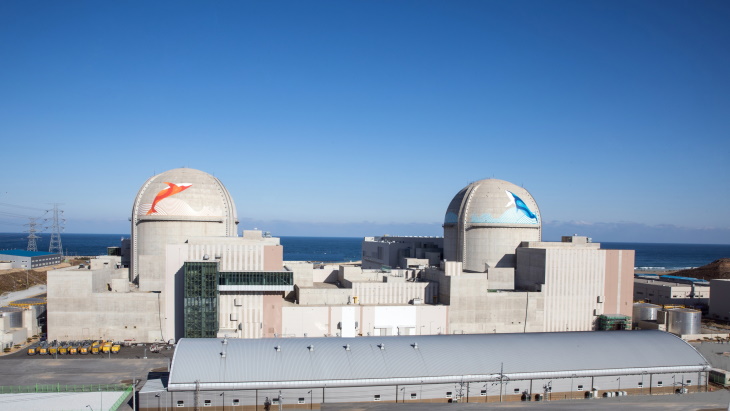South Korean APR-1400 starts up
Unit 1 of the Shin Hanul nuclear power plant in South Korea has attained a sustained chain reaction for the first time, Korea Hydro & Nuclear Power (KHNP) announced. The unit - the first of two APR-1400 reactors at the site - is scheduled to be connected to the grid next month.

Units 1 and 2 of the Shin Hanul plant (Image: KHNP)
The 1350 MWe pressurised water reactor reached first criticality at 11.00am on the 22 May, KHNP said.
"In the future, Shin Hanul Unit 1 plans to produce electricity for the first time early next month after undergoing a performance test of the power plant system with safety as the top priority," the company said.
Ground breaking for the first two units at the Shin Hanul (formerly Shin Ulchin) site took place in May 2012. First concrete for unit 1 was poured two months later, with that for unit 2 following in June 2013. The reactors were originally expected to enter service in April 2017 and April 2018, respectively. Following delays, fuel loading in unit 1 had been scheduled for June 2019 but was postponed pending safety checks by the Nuclear Safety and Security Committee (NSSC) and some modifications. Commercial operation of unit 1 was then expected in July 2021, and unit 2 in May 2022, but there have been further delays.
On 9 July 2021, the NSSC gave its conditional approval for the start-up of Shin Hanul 1. KHNP began loading the first of the fuel assemblies into the core of the reactor five days later. KHNP announced on 13 October that, following the completion of fuel loading, it was conducting reactor physics and systems testing under normal operating temperature and pressure conditions. In July, the company said these tests were expected to take about eight months to complete.
The APR-1400 is an evolutionary pressurised water reactor with its origins in the CE System 80+ model. Principally designed by Korea Engineering Company, it produces 1400 MWe and has a 60-year design life. It supersedes the standardised 995 MWe OPR-1000 design, of which South Korea built 12. The APR-1400 features improvements in operation, safety, maintenance and affordability based on accumulated experience as well as technological development.
KHNP noted Shin Hanul 1 is the first power reactor in South Korea to achieve technological independence through localisation of core facilities, such as the reactor coolant pump and the plant instrumentation and control system.
In October 2017, European Utility Requirements - a technical advisory group for European utilities on nuclear power plants - approved the APR-1400 reactor design. The US Nuclear Regulatory Commission certified the APR-1400 in August 2019, finding the design fully meets US safety requirements.
The first two APR-1400 units - Shin Kori 3 and 4 - entered commercial operation in December 2016 and September 2019, respectively. Construction of two further APR-1400s as Shin Kori units 5 and 6 began in April 2017 and September 2018. These are scheduled to be commissioned in March 2023 and June 2024.
South Korea's new President, Yoon Suk-yeol, has vowed to reverse former President Moon Jae-in's policy of phasing out nuclear power, a policy which was brought in after he assumed office in 2017, and followed the 2011 Fukushima Daiichi accident in Japan. There has been speculation the new government will restart construction of two further APR-1400s as Shin Hanul units 3 and 4, continue to operate current nuclear reactors for longer and keep the country's energy share of nuclear at about 30%.
Four APR-1400s have also been built at Barakah in the United Arab Emirates, the first export order for the reactor design. The first two of these units were connected to the grid in August 2020 and September 2021, respectively.
Researched and written by World Nuclear News
- China Institute of Atomic Energy
- Nuclear Power Institute of China
- Southwestern Institute of Physics
- China Nuclear Power Operation Technology Corporation, Ltd.
- China Nuclear Power Engineering Co., Ltd.
- China Institute for Radiation Protection
- Beijing Research Institute of Uranium Geology (BRIUG)
- China Institute of Nuclear Industry Strategy (CINIS)
- China Nuclear Mining Science and Technology Corporation


